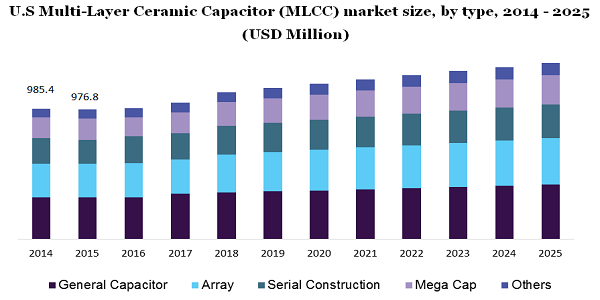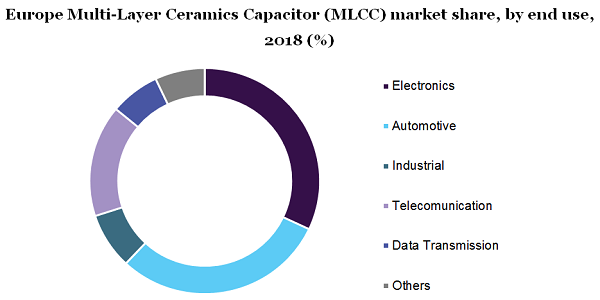- US: +1-408-610-2300
- Toll Free: +1-866-831-4085
- Become a Client
The global multi-layer ceramic capacitor (MLCC) market size was accounted for USD 8.75 billion in 2018. It is estimated to exhibit 5.1% CAGR over the forecast duration, 2019 to 2025. Increasing demand for this ceramic capacitor in various sectors such as telecommunications, consumer electronics, and data processing is attributing to the growth of the market.
Alternate layers of metal and ceramic are used to manufacture MLCCs. At higher operating frequencies, these capacitors have low impedance. This property makes it ideal for noise suppression required in consumer electronics. Further, the growing demand for multi-layer ceramic in consumer electronics such as tablets and smartphones is bolstering the market growth.

The advent of innovative designs with decoupling enhanced bypassing capabilities, filtering, and higher capacitance supplementing the market growth. These innovative designs ensure improved charge capacity and thinner layers. Further, these multi-layer ceramics are used in AC-AC and DC-DC converters to suppress Electromagnetic Interference (EMI).
Multi-layer ceramic capacitors are integrated into smart LED and LCD televisions. In the recent past, such televisions have gained their popularity, which, in turn, is driving the market growth. Further, due to reliability and longer service life, MLCCs are anticipated to be used in IoT devices.
In addition, MLCCs are increasingly used in wireless access points, digital cameras, PC servers, and electronic control units. However, MLCCs require care, as they are prone to damage. This factor is estimated to cause hindrance to the growth of the market.
In 2018, the general capacitor category accounted for USD 2.71 billion. Increasing use of this segment in cellular telephones, memory modules, televisions, LCDs, gaming machines, and DC-DC converters is driving the segment growth. In addition, these capacitors help in removing noise in electronic devices. Further, their smaller sizes enable easy installation in different electronic devices.
Passive technology is used in MLCC arrays, in which several capacitor components are integrated into a single monolithic structure. They find their applications in LCD modules, automotive, telecommunications, and game consoles.
Depending on the rated voltage range, the MLCC market is segregated into high-range voltage and mid-range voltage. High-range voltage MLCCs (1000 V and more) use advanced dielectric thin layers of ceramics and multi-laying technologies to provide high voltage and high capacitance to electronic devices. Further, they find their applications in coupling capacitors having a high voltage, inverters circuits, lighting ballasts, and switch-mode power supply among others.
On the other hand, mid-range voltage MLCCs (100V to 630V) provide better capacitance to volume ratio, no polarity, low leakage, low cost, and thus, used in various electronic devices. In addition, these capacitances provide enhanced mechanical strength along with comparatively lower Equivalent Series Resistance (ESR) to electrolytic capacitors.
By dielectric type, X7R dielectric has the highest operating temperature and it is known to be temperature stable. Owing to its features, it is suitable for applications such as bypass & decoupling. Further, they are also used in filtering as well as suppression of transient voltage.
On the other hand, Y5V dielectric has wide capacitance along with smaller size, and it is used for wave and vapor solder. Y5V is used whenever decoupling applications for the limited range is needed. Further, they are recyclable, easy in handling.
MLCCs are used in different electronic equipment, which is further used in automobiles. The use of MLCCs enabled components in powertrain, infotainment systems, and vehicles frames is prevalent. Manufacturers are focusing on developing MLCCs that can be used for a wide range of applications. Further, the use of MLCCs is also gaining traction in electric vehicles.

Sectors such as military, telecom, industrial equipment, and medical are the main end-users of MLCCs. They find their applications in lasers, high-frequency RF, telecom base stations, and military communication. Advantages such as low inductance, easy mounting ability on circuit boards, and improved assembly efficiency are attributing to their wide application.
In 2018, APAC accounted for the largest share with USD 3.18 billion. The growing use of MLCC in electronic devices is attributing to the growth of the region. In addition, several countries like Taiwan, China, India, South Korea, and Japan have MLCCs manufacturers.
Further, APAC is anticipated to be the fastest-growing segment from 2019 to 2025. Factors such as capacitors miniaturization and rising applications from end-use industries are driving regional growth. In addition, market players are focusing on improved technology to stay competitive. Increasing demand for consumer electronics in countries like India and China is projected to supplement the market growth.
The outbreak of COVID-19 has adversely affected the multi-layer ceramic capacitor market. Electronics, telecommunication and data transmission is the major application for MLCCs. Owing to the pandemic outbreak; several industries were forced to close. Although, few industries kept on operating in digital mode, however, the poor supply chain has significantly disrupted their operations. Further, low demand has resulted in a lack of spending on research and development by companies, which, in turn, delayed the arrival of new multi-layer ceramic capacitors. COVID-19 has resulted in a financial crisis as well, thereby, limiting consumer spending and negatively affecting the market growth.
Despite the adverse impact on their operations, companies can opt for various strategic measures to revive their businesses. Key players in the market can focus on acquiring smaller firms for their sustainability. Further, they can collaborate with e-commerce giants to counter the disruption in the supply chain. In addition, companies can cut their capital expenditure while increasing their focus on research and development to emerge stronger in the next few years.
Key players operating in the region are Kyocera Corporation, Taiyo Yuden Co, TDK Corporation, Murata Manufacturing, and Future Electronics among others. These players are emphasizing strategic initiatives such as mergers & acquisitions, partnerships, and new product launches. In addition, companies are also focusing on expanding their business presence.
For example, Samsung Electro-Mechanics, in 2018, introduced an MLCC plant in China to improve MLCC businesses in the country. Market players are also focusing on offering reliable and cost-effective products to gain competitive advantages.
|
Attributes |
Details |
|
The base year for estimation |
2018 |
|
Actual estimates/Historical data |
2014 - 2017 |
|
Forecast period |
2019 - 2025 |
|
Market representation |
Revenue in USD Million and CAGR from 2019 to 2025 |
|
Regional scope |
North America, Europe, Asia Pacific, Latin America, and MEA |
|
Country scope |
U.S., Canada, Germany, U.K., China, India, Japan, and Brazil |
|
Report coverage |
Revenue forecast, company ranking, competitive landscape, growth factors, and trends |
|
15% free customization scope (equivalent to 5 analyst working days) |
If you need specific information that is not currently within the scope of the report, we will provide it to you as a part of the customization. |
This report forecasts revenue growth at global, regional, and country levels, and provides an analysis of the latest industry trends in each of the sub-segments from 2014 to 2025. For this study, Million Insights has segmented the global multi-layer ceramic capacitor (MLCC) market report based on type, rated voltage range, dielectric type, end-use, and region:
• Type Outlook (Revenue, USD Million, 2014 - 2025)
• General Capacitor
• Array
• Serial Construction
• Mega Cap
• Others
• Rated Voltage Range Outlook (Revenue, USD Million, 2014 - 2025)
• Low Range (Up to 50V)
• Mid-Range (100V to 630V)
• High Range (1000V & above)
• Dielectric Type Outlook (Revenue, USD Million, 2014 - 2025)
• X7R
• X5R
• C0G
• Y5V
• Others
• End-Use Outlook (Revenue, USD Million, 2014 - 2025)
• Electronics
• Automotive
• Industrial
• Telecommunication
• Data Transmission
• Others
• Regional Outlook (Revenue, USD Million, 2014 - 2025)
• North America
• The U.S.
• Canada
• Europe
• Germany
• The U.K.
• the Asia Pacific
• China
• India
• Japan
• Latin America
• Brazil
• Middle East & Africa (MEA)


Research Support Specialist, USA